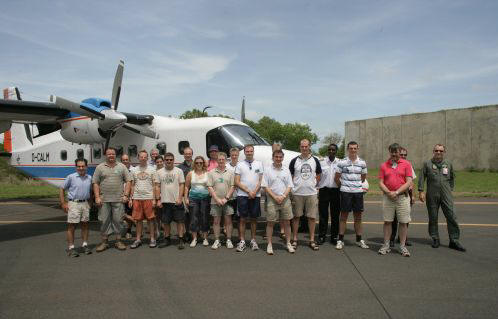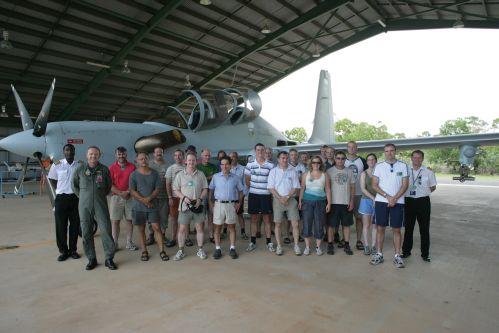
Aerosol and chemical transport in tropical convection

NERC-funded consortium project involving the Universities of Manchester, Cambridge and York (UK); DLR and Forschungzentrum Julich (Germany); York University (Canada), NCAR (USA), Bureau of Meteorology (Australia) and Airborne Research Australia.
ACTIVE combines field measurements and a range of modelling tools at different scales to address the question of what determines the composition of the upper tropical troposphere (or tropical tropopause layer, TTL) - is it rapid upward transport in deep convection or slow large-scale transport? The field measurements were conducted in Darwin, Australia in two phases - the first in November/December 2005 to study pre-monsoon convection (the Hector storms over the Tiwi Islands) and the second in January/February 2006 to study monsoon convection. In both phases ACTIVE collaborated with other international campaigns at Darwin - the EU SCOUT-O3 project in November/December and the US/Australian TWP-ICE project during the monsoon period. The focus of all the campaigns were on aircraft measurements: ACTIVE used the Australian Egrett aircraft and the NERC Dornier to measure chemical and aerosol species in the inflow and outflow of tropical storms. The measurements are interpreted using cloud-scale modelling and large-scale modelling to distinguish the contribution of different sources to the TTL.
Dates of field campaigns at Darwin: Nov 7 – Dec 9 2005 and Jan 16 – Feb 17 2006
Presentation describing ACTIVE (ppt file)
Planning documents and data - project members only. Password needed to enter this site. Contact geraint.vaughan@manchester.ac.uk or grant.allen@manchester.ac.uk to get a username and password.
|
Presentations at Final ACTIVE meeting, 21 May 2009
David_Waddicor_Egrett_aerosol.ppt
Airborne Research Australia (Egrett) NERC Airborne Remote Sensing Facility (Dornier)
|
Papers published from ACTIVE Allen, G., et al, 2008. Aerosol and trace-gas measurements in the Darwin area during the wet season. J. Geophys. Res, 113, D06306, doi:10.1029/2007JD008706. Correction to “Aerosol and trace-gas measurements in the Darwin area during the wet season”,J. Geophys. Res., 113, D23303, doi:10.1029/2008JD011284, 2008. Allen, G., et al. 2009. Modulation of tropical convection by breaking Rossby waves. Quart. J. Roy. Meteorol. Soc. 135, 125-137. Baran et al 2011 Using in situ estimates of ice water content, volume extinction coefficient, and the total solar optical depth obtained during the tropical ACTIVE campaign to test an ensemble model of cirrus ice crystals. Quart J. Roy Met Soc. 137, 199-218, DOI: 10.1002/qj.731, 2011. Brunner, D., et al., 2009. The SCOUT-O3 Darwin Aircraft Campaign: rationale and meteorology, Atmos. Chem. Phys., 9, 93-117. Chemel, C, et al. 2008. Quantifying the Imprint of a Severe Hector Thunderstorm during ACTIVE/SCOUT-O3 onto the Water Content in the Upper Troposphere/Lower Stratosphere. Monthly Weather Review, early online release, DOI: 10.1175/2008MWR2666.1 Hamilton, J. F., et al. 2008. Observations of an Atmospheric Chemical Equator and its implications for the Tropical Warm Pool Region. J. Geophys. Res., 113, D20313, doi:10.1029/2008JD009940, 2008. Heyes, W. J., et al., 2009. Composition of the TTL over Darwin: local mixing or long-range transport? Atmos. Chem. Phys. Discuss., 9, 7299-7332. Labrador, L., et al., 2009. Lightning-Produced NOx during the northern Australian monsoon: results from the ACTIVE campaign. Atmos. Chem. Phys. Discuss., 9, 10647-10673, 2009. May, P. T., et al. 2008. The Tropical Warm Pool International Cloud Experiment (TWPICE). Bull. Amer. Meteorol. Soc., 89, 632 - 645.. , 2009. Aerosol and thermodynamic effects on tropical cloud systems during TWPICE and ACTIVE. Atmos. Chem. Phys., 9, 15-24. Vaughan, G., et al., 2008. Studies in a natural laboratory: High-altitude aircraft measurements around deep tropical convection. Bull. Amer. Meteorol. Soc., 89, 647 – 662.
|
 |
 |